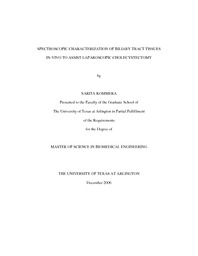
ATTENTION: The works hosted here are being migrated to a new repository that will consolidate resources, improve discoverability, and better show UTA's research impact on the global community. We will update authors as the migration progresses. Please see MavMatrix for more information.
Show simple item record
| dc.contributor.author | Kommera, Sarita | en_US |
| dc.date.accessioned | 2007-08-23T01:56:40Z | |
| dc.date.available | 2007-08-23T01:56:40Z | |
| dc.date.issued | 2007-08-23T01:56:40Z | |
| dc.date.submitted | December 2006 | en_US |
| dc.identifier.other | DISS-1583 | en_US |
| dc.identifier.uri | http://hdl.handle.net/10106/404 | |
| dc.description.abstract | Laparoscopic Cholecystectomy is a surgical method for removal of gallbladder when it is diseased with gall stones. Almost 750,000 people are affected with this disease annually in USA. Gall bladder is removed by placing an incision on the cystic duct. This duct is totally embedded in fat (which is a few mm thick) in most of the cases and it becomes a huge problem decreasing the visual capability of the surgeon to distinctly locate the duct.
Near Infrared Spectroscopy (NIRS) can solve the fuzziness as it penetrates in a few mm thick tissues. NIRS is one of the simplest techniques for studying the physiological properties of the biological tissue. Light delivered into the tissue undergoes multiple scattering and absorption, and reflects back carrying quantitative information. Light attenuation in the Near Infrared Red (700-900nm) region is relatively less by tissue chromophores thus allowing to study their variation in this wavelength region. | en_US |
| dc.description.sponsorship | Liu, Hanli | en_US |
| dc.language.iso | EN | en_US |
| dc.publisher | Biomedical Engineering | en_US |
| dc.title | Spectroscopic Characterization Of Biliary Tract Tissues In-vivo To Assist Laparoscopic Cholecystectomy | en_US |
| dc.type | M.S. | en_US |
| dc.contributor.committeeChair | Liu, Hanli | en_US |
| dc.degree.department | Biomedical Engineering | en_US |
| dc.degree.discipline | Biomedical Engineering | en_US |
| dc.degree.grantor | University of Texas at Arlington | en_US |
| dc.degree.level | masters | en_US |
| dc.degree.name | M.S. | en_US |
| dc.identifier.externalLink | https://www.uta.edu/ra/real/editprofile.php?onlyview=1&pid=28 | |
| dc.identifier.externalLinkDescription | Link to Research Profiles | |
Files in this item
- Name:
- umi-uta-1583.pdf
- Size:
- 3.627Mb
- Format:
- PDF
This item appears in the following Collection(s)
Show simple item record


